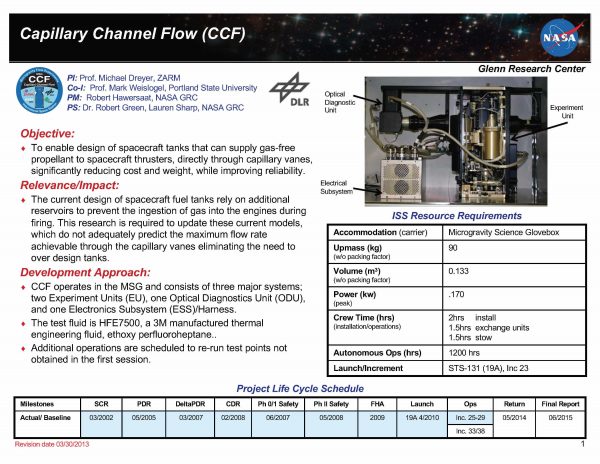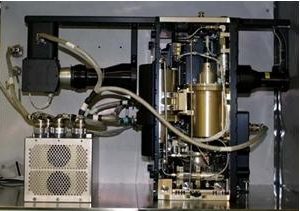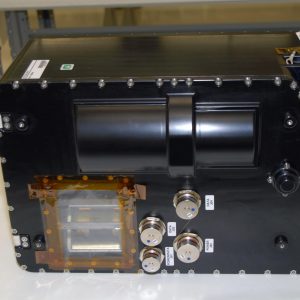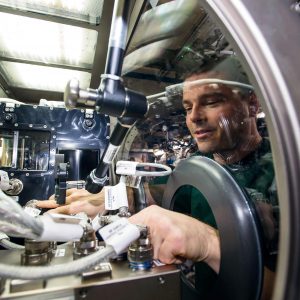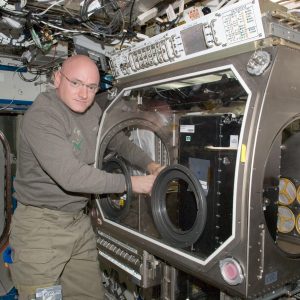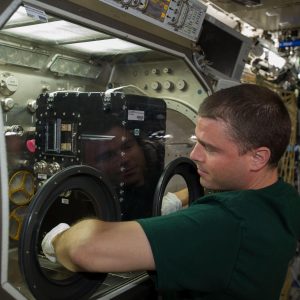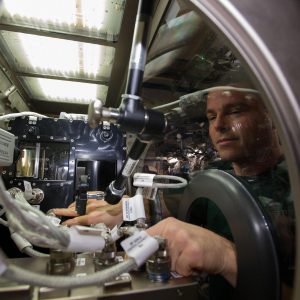CCF
Capillary Channel Flow
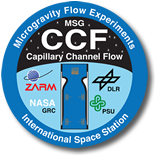
Capillary Channel Flow (CCF) was a versatile experiment performed on the International Space Station for studying a critical variety of inertial-capillary dominated flows key to spacecraft systems that cannot be studied on the ground. CCF’s results helped innovate applications in the aerospace community challenged by the containment, storage, and handling of large liquid inventories (fuels, cryogens, and water) aboard spacecraft.
Results were immediately useful for the design, testing, and instrumentation for validation of liquid management systems of current orbiting, design stage, and advanced spacecraft envisioned for future lunar and Mars missions. They also helped improve life support system design, phase separation, and enhance current system reliability.
Technologies for liquid management in space use capillary forces to position and transport liquids due to the absence of hydrostatic pressure in microgravity. On earth, the effect of capillary forces is limited to a few millimeters. In space, these forces affect free surfaces that extend meters.
Design knowledge of open capillary channel flow is critical for their integration in spacecraft propellant tanks. Their limitations are based on the restriction that the liquid fuel must be free of bubbles prior to entering the thrusters.
Spacecraft fuel tanks currently rely on an additional reservoir to prevent the ingestion of gas into the engines during firing. Research is required to update current models, which don’t adequately predict the maximum flow rate achievable through the capillary vanes.
CCF tested the theoretical predictions for the free surface shapes and the critical flow velocities for open capillary channel flows in microgravity. CCF was designed to validate the theories used to develop governing equations. The experiments provided verifications for the flow rate limits and corresponding critical flow velocities.
Of the myriad of geometries envisioned for the capillary control of fluids in low–gravity environments, CCF examined flows in parallel plate channels, grooves, and interior corner capillary conduits. These geometries represented a class of practical capillary geometries implemented in designs of the aerospace industry’s fuel and tank sectors.
Current spacecraft fluid processing equipment is replete with such constructs. Validation of theoretical models developed for such geometries is expected to lend confidence to their application to other geometries pertinent to advanced microgravity fluid systems development.
Highlights of the CCF experiments may be described as follows:
- Provide performance limits for capillary dominated systems such as passive fluids management—capillary collection, pumping, and containment—and processes such as passive phase separation and transport. This is a pressing requirement for a wide range of spacecraft fluid systems.
- CCF will use multiple test cell geometries and variable parameter ranges to investigate capillary systems’ ability to passively change multiphase flow regimes. It will also be used to study capillary dominated multiphase flow that may be exploited to assist other active or passive systems.
- CCF will provide critical data for the uniquely low–gravity inertial-capillary flow regime important to liquid fuels and cryogen storage and management.
Methods
Forced liquid flows through open capillary channels with free liquid surfaces were investigated in the Microgravity Science Glovebox aboard ISS. In open capillary channels, if a certain critical flow rate was exceeded, the flow became unsteady, surfaces collapsed, and gas ingestion occurred at the outlet. [Add paragraph.]
From a fluid mechanics point of view, a critical velocity must exist at which the steady subcritical flow turns into an unsteady supercritical flow, which prompts the collapse of the free surface. The surface profile must be measured with great accuracy to find this critical velocity. Local flow velocity must also be known at designated points of the channel.
The experiment was designed as a modular system consisting of the Fluid Management System (FMS), the Board Computer (BC), and two Experiment Units (EU), which included the Test Units (TU). For investigation of the selected channel geometries—parallel plates channel, groove channel, and a wedge-shaped channel—and different channel dimensions, TUs were exchangeable.
This versatility also enabled the use of the setup for other projects with similar technology-driven research objectives. TU2 included a gas bubble generator to test two-phase flow stability.
The FMS was equipped with components required to establish flow—pumps, plungers, and valves—while the EU contained the TU, a phase separation chamber, a compensation tube, cameras for the video observation as well as required illumination. The BC performed experiment control, sampling of housekeeping data, and communication with both the MSG interfaces and the ground station.
The experiments took place on the ISS in 2010, 2011, 2013, and 2014. ISS operations were controlled from ground stations in Portland, Oregon and Bremen, Germany.
Gallery
Related documents
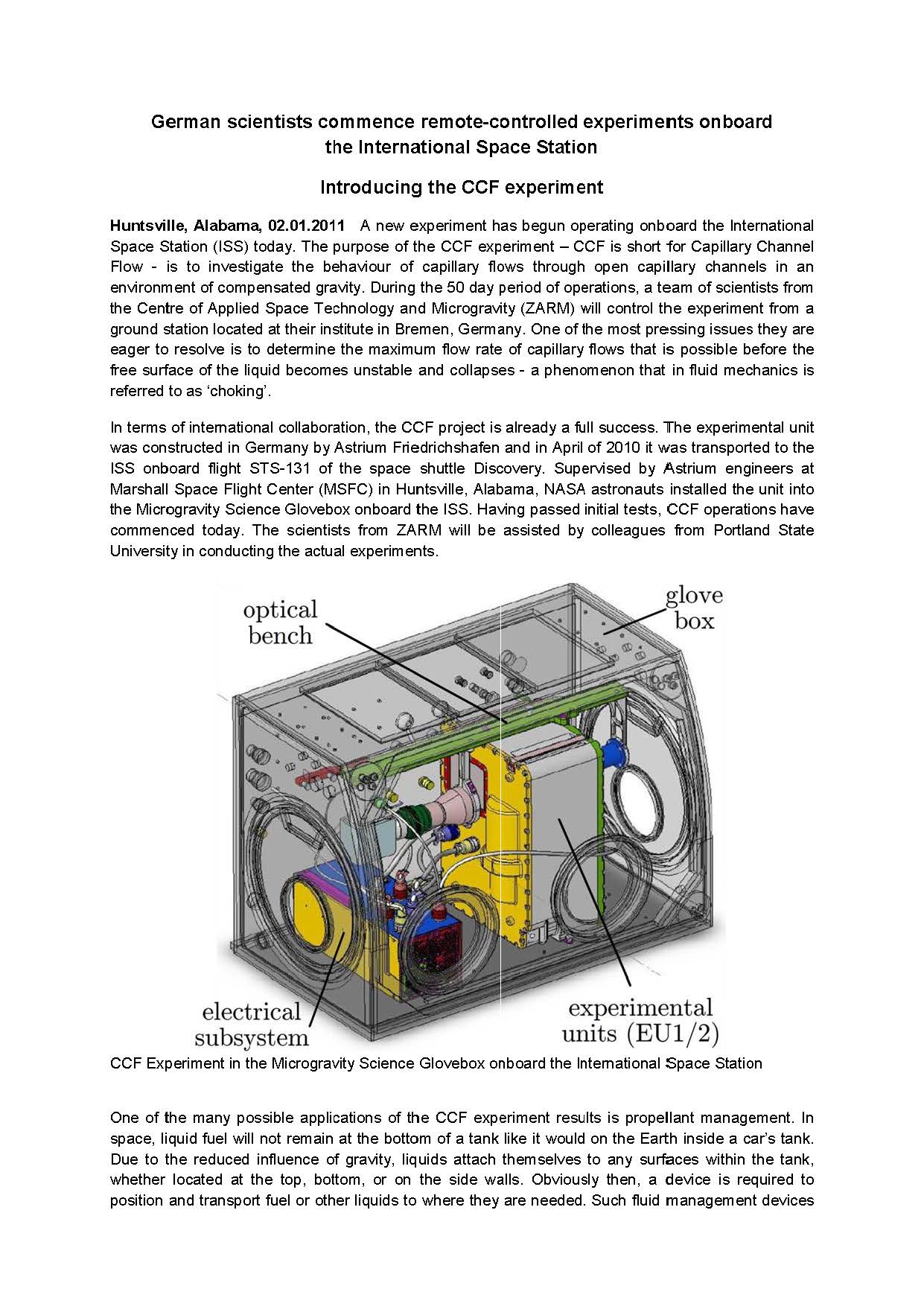 |
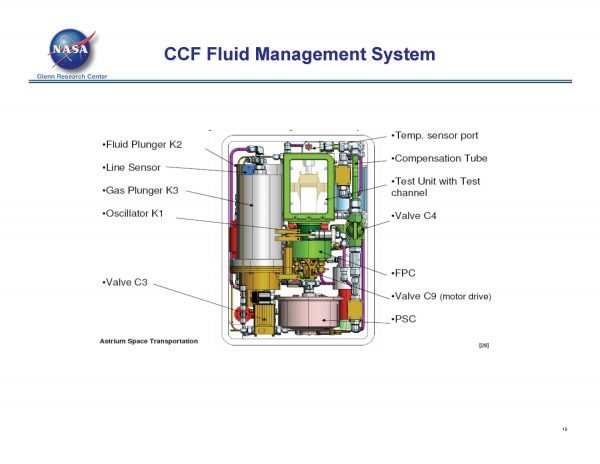 |
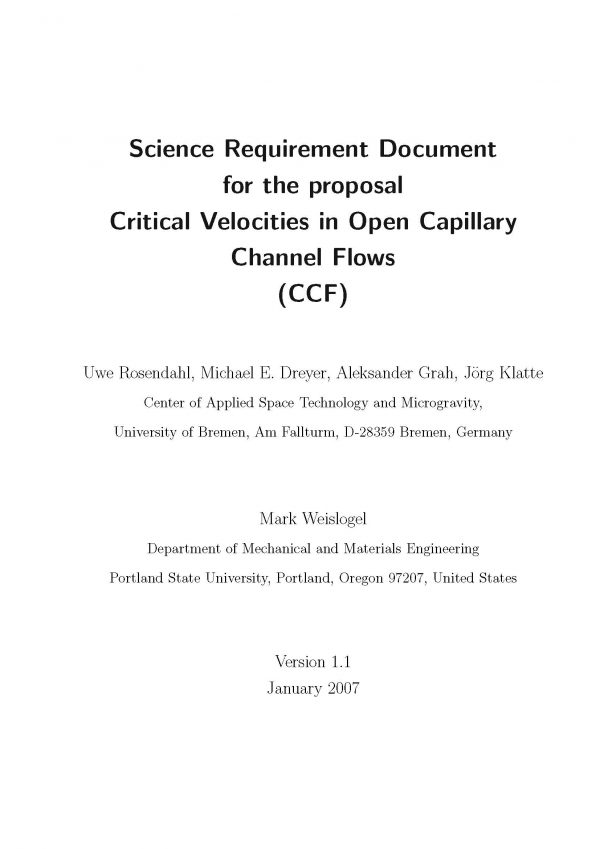 |
Publications
The CCF Experiment investigates forced liquid flow through partially open capillary channels aboard the International Space Station (ISS). The flow channel is made up of either two parallel plates or an open wedge conduit. Results collected show favorable agreement with predictions of critical flow rates and bubble separation rates. The results also indicate the nature of destabilizations and the myriad outcomes of gas liquid flows in the microgravity environment. Regarding critical flow rate limitations, in general, steady uninterrupted flow is possible as long as it is below the bubble-ingestion speed. However right at this “critical” point, the flow speed of the fluid is counteracted equally by resisting waves going the opposite direction and quickly gives rise to the instability, called choking, which causes ingestion of bubbles into the moving fluid. At this point, the maximum flow rate is achieved briefly before the free fluid surface collapses and ingests air. The results suggest that these limitations are primarily governed by flow velocity, intrinsic properties of the liquid (i.e., surface tension, density, viscosity, wetting condition), and the steady balance of directional forces exerted on the moving fluid. For passive bubble separations in wedge sectioned conduits the studies have suggest devices that can be applied directly to perform such task beyond such fundamental investigations. Researchers are continuing to experiment with different capillary channel designs, fluids, and flow velocities to study and improve computational models for predicting capillary channel flow behavior in space which can translate into fabricating efficient fluid transport systems for fuel, life support, and energy systems for space exploration.
Results Publications
- Bronowicki PM, Canfield PJ, Grah A, Dreyer ME. Free surfaces in open capillary channels—Parallel plates. Physics of Fluids. 2015 January; 27(1): 012106. DOI: 10.1063/1.4906154. DOI: 10.1063/1.4906154
- Weislogel MM, Wollman AP, Jenson RM, Geile JT, Tucker JF, Wiles JA, Trattner AL, DeVoe C, Sharp LM, Canfield PJ, Klatte J, Dreyer ME. Capillary Channel Flow (CCF) EU2-02 on the International Space Station (ISS): An Experimental Investigation of Passive Bubble Separations in an Open Capillary Channel. NASA Technical Memorandum. 2015 June; NASA/TM-2015-21872068 pp.
- Canfield PJ, Bronowicki PM, Chen Y, Kiewidt L, Grah A, Klatte J, Jenson RM, Blackmore W, Weislogel MM, Dreyer ME. The capillary channel flow experiments on the International Space Station: experiment set-up and first results. Experiments in Fluids. 2013 May 8; 54(5): 1519. DOI: 10.1007/s00348-013-1519-1. DOI: 10.1007/s00348-013-1519-1
- Conrath M, Canfield PJ, Bronowicki PM, Dreyer ME, Weislogel MM, Grah A. Capillary channel flow experiments aboard the International Space Station. Physical Review E, Statistical, Nonlinear, and Soft Matter. 2013 88(6): 063009. DOI: 10.1103/PhysRevE.88.063009. DOI: 10.1103/PhysRevE.88.063009
- Jenson RM, Wollman AP, Weislogel MM, Sharp LM, Green RD, Canfield PJ, Klatte J, Dreyer ME. Passive phase separation of microgravity bubbly flows using conduit geometry. International Journal of Multiphase Flow. 2014 June; epubDOI: 10.1016/j.ijmultiphaseflow.2014.05.011. DOI: 10.1016/j.ijmultiphaseflow.2014.05.011
- Grah A, Canfield PJ, Bronowicki PM, Dreyer ME, Chen Y, Weislogel MM. Transient capillary channel flow stability: Experiments on the International Space Station. Microgravity Science and Technology. 2014 December; 26(6): 385-396. DOI: 10.1007/s12217-014-9403-z. DOI: 10.1007/s12217-014-9403-z
Past Publications
- Grah, A., Haake, D., Rosendahl, U., Klatte, J., Dreyer, M. E. “Stability limits of unsteady open capillary channel flow (CCF),” Journal of Fluid Mechanics (submitted 2007, first review received, revised version in progress).
- Rosendahl, U., Dreyer, M.E. “Design and performance of an experiment for the investigation of open capillary channel flows,” Exp. Fluids, 42,683 (2007).
- Dreyer, M. E. “Free Surface Flows under Compensated Gravity Conditions,” Series: Springer Tracts in Modern Physics, Vol. 221: Springer-Verlag (2007).
- Haake, D., Rosendahl, U., Ohlhoff, A., Dreyer, M.E. “Flow Rate Limitation in Open Capillary Channel Flows,” New York Academy of Sciences, 1077, 443 (2006).
- Rosendahl, U., Fechtmann, C., Dreyer, M.E., “Sounding Rocket Experiment on Capillary Channel Flow,” Proceedings of the 17th ESA Symposium on European Rocket and Balloon Programmes and Related Research, ESA SP-590, May 30-June 2, Sandefjord, Norway, 2005.
- Ohlhoff, A., Rosendahl, U., Dreyer, M.E. “Test-Case NO 35: Flow Rate Limitation in open Capillary Channels (PE),” Multiphase Science and Technology 16.1, 259 (2004).
- Rosendahl, U., Ohlhoff, A., Dreyer, M.E. “Choked flows in open capillary channels: theory, experiment and computations,” Journal of Fluid Mechanics 518, 187-214 (2004).
- de Lazzer, A., Stange, M., Dreyer, M.E. “Influence of lateral acceleration on capillary interfaces between parallel plates,” Microgravity sci. technol. 14.4, 3 (2003)
- Rosendahl, U., Ohlhoff, A., Dreyer, M.E., Rath, H. J. “Choked Flows in Open Capillary Channel,” Proc. Appl. Math. Mech. 2, 328 (2003).
- Rosendahl, U., Ohlhoff, A., Dreyer, M.E., Rath, H. J. “Investigation of Forced Liquid Flows in Open Capillary Channels,” Microgravity sci. technol. 13.4, 53 (2002).
- Rosendahl, U., Dreyer, M.E., Rath, H.J., Motil, B. “Critical Velocity in Open Capillary Channel Flows,” AIAA 2001-5021 (2001).
- Weislogel, M.M., Weir, T., M. Dreyer, “Capillary Solutions: Passive Containment and Transport for Low-g Fluids Systems,” Habitation 2006, Int. Journal for Human Support Research, Vol. 10, No. 3/4, p. 244, February, 2006.
- Dreyer, M., Weislogel, M.M., “Capillary Channel Flows (CCF): Parametric Regimes for low-g Fluids Transport,” Habitation 2006, Int. Journal for Human Support Research, Vol. 10, No. 3/4, p. 233, February, 2006.
- Chen, Y., Weislogel, M. M. & Nardin, C. “Capillary-driven flows along rounded interior corners,” J. Fluid Mech. 566(2006), 235-271.
- Grah, A., Dreyer, M.E.: One-dimensional and three-dimensional computation of capillary channel flow, accepted by Phys. Fluids (2009).
- Salim, A., Colin, C., Dreyer, M. E.: Experimental Investigation of a Bubbly Two-Phase Flow in an Open Capillary Channel under Microgravity Conditions, Microgravity Sci. Technol., DOI10.1007 s12217-009-9115-y(2009).
- Grah, A., Haake, D., Rosendahl, U., Klatte, J., Dreyer, M. E.: Stability limits of unsteady open capillary channel flow, J. Fluid Mech. 600, 271-289 (2008).
- Klatte, J., Haake, D., Weislogel, M. M., Dreyer, M. E.: A Fast Numerical Procedure for Steady Capillary Flow in Open Channels, Acta Mech. DOI 10.1007 s00707-008-0063-1 (2008).
- Rosendahl, U., Dreyer, M. E.: Design and performance of an experiment for the investigation of open capillary channel flows, Exp. Fluids, 42, 683-696 (2007).
- Ohlhoff, A., Rosendahl, U., Dreyer, M.E.: Flow Rate Limitation in open Capillary Channels, Multiphase Science and Technology *16.1-3*, 259 (2004).
- Rosendahl, U., Ohlhoff, A., Dreyer, M.E.: Choked flows in open capillary channels: theory, experiment and computations, J. Fluid Mech. *518*, 187 (2004).
Contact Information
Principal Investigator: Prof. Michael Dreyer, University of Bremen
Co-Investigator: Prof. Mark Weislogel, Portland State University
Project Manager: Robert Hawersaat, NASA GRC
Project Scientists: Dr. Robert Green and Lauren Sharp, NASA GRC

